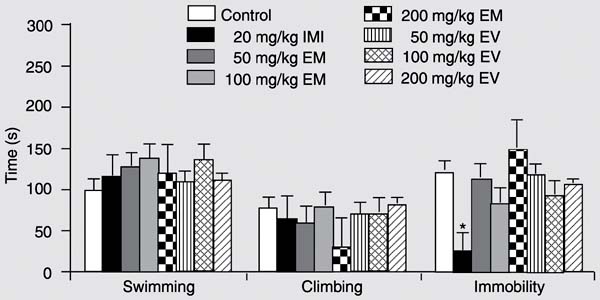Erythrina velutina (EV) and Erythrina mulungu (EM), popularly used in Brazil as tranquilizing agents, were studied. The effects of acute and chronic oral treatment with a water:alcohol extract of EV (7:3, plant grounded stem bark; acute = 100, 200, 400 mg/kg; chronic = 50, 100, 200 mg/kg) were evaluated in rats (N = 11-12) submitted to the elevated T-maze (for avoidance and escape measurements) model of anxiety. This model was selected for its presumed capacity to elicit specific subtypes of anxiety disorders recognized in clinical practice: avoidance has been related to generalized anxiety and escape to panic. Additionally, animals were treated with the same doses of EV and EM (water:alcohol 7:3, inflorescence extract) and submitted to the forced swim test for the evaluation of antidepressant activity (N = 7-10). Both treatment regimens with EV impaired elevated T-maze avoidance latencies, without altering escape, in a way similar to the reference drug diazepam (avoidance 1, mean ± SEM, acute study: 131.1 ± 45.5 (control), 9.0 ± 3.3 (diazepam), 12.7 ± 2.9 (200 mg/kg), 28.8 ± 15.3 (400 mg/kg); chronic study: 131.7 ± 46.9 (control), 35.8 ± 29.7 (diazepam), 24.4 ± 10.4 (50 mg/kg), 29.7 ± 11.5 (200 mg/kg)). Neither EV nor EM altered measurements performed in the forced swim test, in contrast to the reference drug imipramine that significantly decreased immobility time after chronic treatment. These results were not due to motor alterations since no significant effects were detected in an open field. These observations suggest that EV exerts anxiolytic-like effects on a specific subset of defensive behaviors which have been associated with generalized anxiety disorder.
Erythrina velutina; Erythrina mulungu; Elevated T-maze test; Forced swim test; Anxiety; Depression






